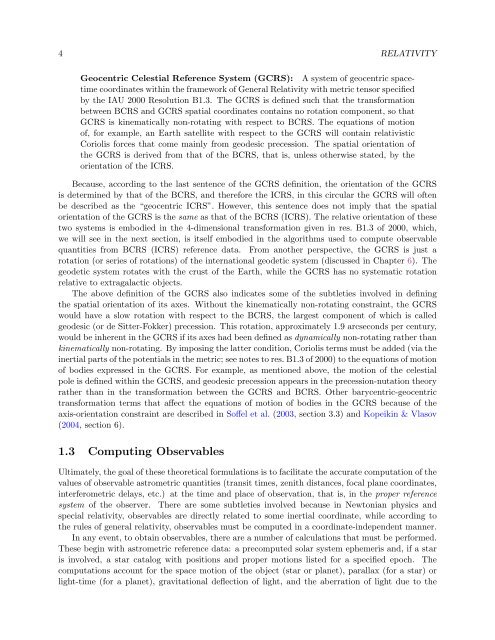USNO Circular 179 - U.S. Naval Observatory
USNO Circular 179 - U.S. Naval Observatory
USNO Circular 179 - U.S. Naval Observatory
Create successful ePaper yourself
Turn your PDF publications into a flip-book with our unique Google optimized e-Paper software.
4 RELATIVITY<br />
Geocentric Celestial Reference System (GCRS): A system of geocentric spacetime<br />
coordinates within the framework of General Relativity with metric tensor specified<br />
by the IAU 2000 Resolution B1.3. The GCRS is defined such that the transformation<br />
between BCRS and GCRS spatial coordinates contains no rotation component, so that<br />
GCRS is kinematically non-rotating with respect to BCRS. The equations of motion<br />
of, for example, an Earth satellite with respect to the GCRS will contain relativistic<br />
Coriolis forces that come mainly from geodesic precession. The spatial orientation of<br />
the GCRS is derived from that of the BCRS, that is, unless otherwise stated, by the<br />
orientation of the ICRS.<br />
Because, according to the last sentence of the GCRS definition, the orientation of the GCRS<br />
is determined by that of the BCRS, and therefore the ICRS, in this circular the GCRS will often<br />
be described as the “geocentric ICRS”. However, this sentence does not imply that the spatial<br />
orientation of the GCRS is the same as that of the BCRS (ICRS). The relative orientation of these<br />
two systems is embodied in the 4-dimensional transformation given in res. B1.3 of 2000, which,<br />
we will see in the next section, is itself embodied in the algorithms used to compute observable<br />
quantities from BCRS (ICRS) reference data. From another perspective, the GCRS is just a<br />
rotation (or series of rotations) of the international geodetic system (discussed in Chapter 6). The<br />
geodetic system rotates with the crust of the Earth, while the GCRS has no systematic rotation<br />
relative to extragalactic objects.<br />
The above definition of the GCRS also indicates some of the subtleties involved in defining<br />
the spatial orientation of its axes. Without the kinematically non-rotating constraint, the GCRS<br />
would have a slow rotation with respect to the BCRS, the largest component of which is called<br />
geodesic (or de Sitter-Fokker) precession. This rotation, approximately 1.9 arcseconds per century,<br />
would be inherent in the GCRS if its axes had been defined as dynamically non-rotating rather than<br />
kinematically non-rotating. By imposing the latter condition, Coriolis terms must be added (via the<br />
inertial parts of the potentials in the metric; see notes to res. B1.3 of 2000) to the equations of motion<br />
of bodies expressed in the GCRS. For example, as mentioned above, the motion of the celestial<br />
pole is defined within the GCRS, and geodesic precession appears in the precession-nutation theory<br />
rather than in the transformation between the GCRS and BCRS. Other barycentric-geocentric<br />
transformation terms that affect the equations of motion of bodies in the GCRS because of the<br />
axis-orientation constraint are described in Soffel et al. (2003, section 3.3) and Kopeikin & Vlasov<br />
(2004, section 6).<br />
1.3 Computing Observables<br />
Ultimately, the goal of these theoretical formulations is to facilitate the accurate computation of the<br />
values of observable astrometric quantities (transit times, zenith distances, focal plane coordinates,<br />
interferometric delays, etc.) at the time and place of observation, that is, in the proper reference<br />
system of the observer. There are some subtleties involved because in Newtonian physics and<br />
special relativity, observables are directly related to some inertial coordinate, while according to<br />
the rules of general relativity, observables must be computed in a coordinate-independent manner.<br />
In any event, to obtain observables, there are a number of calculations that must be performed.<br />
These begin with astrometric reference data: a precomputed solar system ephemeris and, if a star<br />
is involved, a star catalog with positions and proper motions listed for a specified epoch. The<br />
computations account for the space motion of the object (star or planet), parallax (for a star) or<br />
light-time (for a planet), gravitational deflection of light, and the aberration of light due to the


